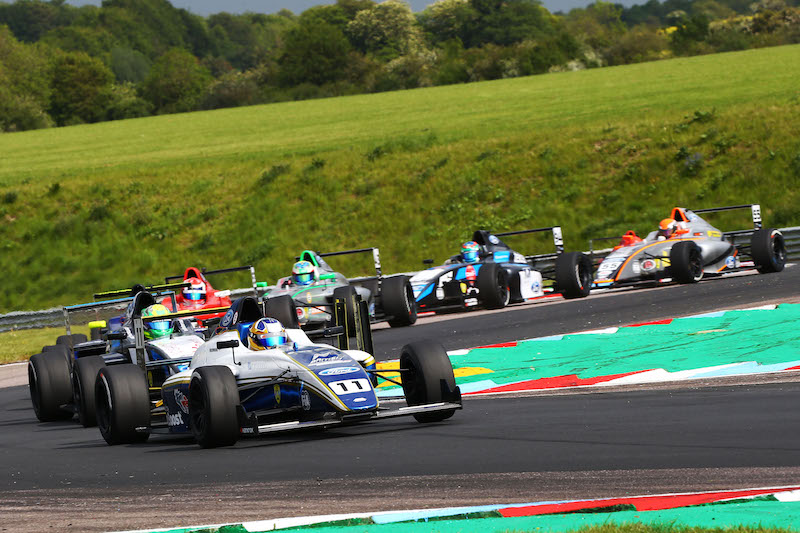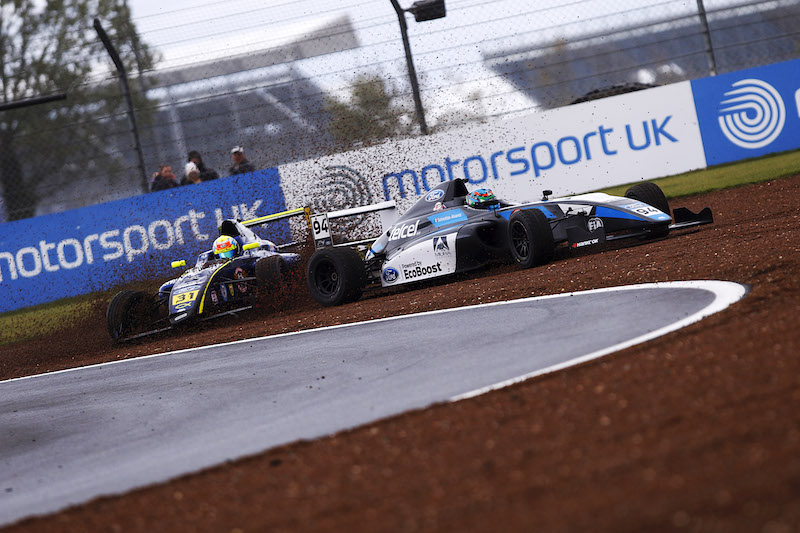
Photo: Jakob Ebrey Photography
In 2016, Carlin’s Max Fewtrell beat a closely matched British Formula 4 field to take the title. Three years later, after a season away, Carlin came back with young Barbadian Zane Maloney at the wheel of the same chassis Fewtrell had driven to victory.
Before that, the #31 Carlin car had won the title with Lando Norris, giving Maloney plenty to live up to. Add to that the fact Maloney had already proven himself as an incredibly talented karter, there were high expectations for the young driver.
But those expectations were not immediately met, as Maloney left the Brands Hatch season opener fourth in the standings.
It was Ginetta Junior graduates Louis Foster (Double R Racing) and Luke Browning (Richardson Racing) that shone at Brands Hatch Indy, but podiums in all three races meant Double R’s sophomore driver Sebastian Alvarez led the standings. All three had proven it was not going to be an easy title for anybody to win, especially with Maloney’s team-mate Joe Turney in the mix. Browning?s climb up from 10th to first in the wet season opener was particularly impressive. But there was also a hint of brilliance from Maloney.?
Maloney should, arguably, have won race two. He had taken the lead early on but came under pressure from Browning. They made contact on the last lap and Maloney fell to seventh, while Browning went on to win (only be penalised for the incident).
The opening round set the stage for a four-way battle between Alvarez, Browning, Foster and Maloney, but the middle two fell away in the first half of the season.
Consistency was Browning?s biggest problem. Watching the Richardson Racing driver storm through the field after disappointing qualifying sessions became a staple of the season, but he couldn?t put a weekend together frequently enough to be a serious title contender. Some of this was no doubt down to the inexperience of the one-car team he was driving for.

Photo: Jakob Ebrey Photography
After Alvarez?s maiden victory in the third Brands race, the momentum at Double R switched to Foster’s side of the garage.
Foster was consistently strong over the first half of the season. He claimed the points lead after two wins at Donington Park, one which featured clashes with Alvarez and Turney, while Maloney dropped 49 points to the front.
But it was at Thruxton, the third round of the season, that Maloney started the charge that would not let up until the field returned to Brands Hatch.
After his breakthrough win in race two, Maloney dominated. At one point, he had seven consecutive victories (although these were later split by a fifth place, when results for the abandoned reverse grid race at Croft were declared official).
Foster continued his consistency, but wasn’t able to hit the podium enough while Maloney was on his winning run.
Midway through the year, it began to look like Maloney?s title might be less like the close-fought championship of Fewtrell and more like Caroline?s dominant victory. After Snetterton, he was more than 50 points ahead of the next closest driver, and showed no sign of stopping. But, after the summer break, there was a resurgence from Double R.
Alvarez had been fairly anonymous in his first year in British F4. While his team-mate Kiern Jewiss stormed to the 2018 title, Alvarez finished 12th of 14 full-time drivers, and behind part-timer driver Hampus Ericsson. Despite coming into 2019 as a second-year driver, Alvarez wasn?t high in many’s title predictions. After his sole win at Brands Hatch, Alvarez had fallen back into the shadow of his team-mate. Until Snetterton.

Photo: Jakob Ebrey Photography
The Mexican dominated the first race of the weekend. After a strong start, he was unchallenged as Maloney and Carter Williams fought for second place. Alvarez was on for another win in race two – albeit inherited from Browning when the Richardson driver again took a penalty – but a wide moment dropped him down the order and left him 11th. But he bounced back in race three to take a lights-to-flag win, reigniting his title hopes and passing his team-mate in the standings.
From that point until the Brands Hatch Grand Prix season finale, no driver claimed points at the same rate as Alvarez. Maloney?s points lead was gradually chipped away as the Carlin driver struggled at Thruxton, Knockhill and Silverstone.?
Alvarez won the second race at Silverstone, climbing up through the order in the wet and beating Maloney by 1.2 seconds. Now, they were equal on points, and would remain that way until the opening race at Brands.
Maloney was leading Alvarez in the final race at Silverstone but would not give an inch to his rival. As Alvarez tried to dive up the inside, Maloney pushed him onto the grass. Alvarez clattered over the kerbs and ran into the side of Maloney, wiping both out of the race.
For a championship that hadn?t really produced a rivalry in the same way Ayrton Simmons versus Kiern Jewiss (and arguably Caroline versus Oscar Piastri) had, it now looked like there was a fight, and, for the first time since Croft, nobody could be sure Maloney would win it.
Throughout the year, Maloney repeated the mantra that he was taking things race-by-race. He would not sit back and settle for second if he knew first was available, even if doing so meant risking retirement. It may have cost him points, but it showed a determination to win. And Carlin wasn’t always happy with that approach.

Photo: Jakob Ebrey Photography
That was almost his undoing in the opening race of the Brands finale. Neither he nor Alvarez qualified well, but a strong start put Maloney in the lead battle heading into the first corner. Unfortunately for him, Foster – who was still in the title fight at this point -? also made a good start and the pair ran side-by-side. It was a fight Maloney did not need to win, nor need to have, but his determination to win put him in a position where contact was inevitable and Foster ended in the gravel.
Maloney was deemed not at fault, and recovered to take victory while Alvarez came home third. Advantage Maloney.
It appeared to be advantage Maloney again in race two when, despite leading from start to finish, Alvarez was handed a 10-second penalty for jumping the start. It dropped him to fifth, while Maloney took fourth. But Alvarez?s penalty was rescinded, putting him back on the top step and in the championship lead ahead of the final race.
The season finale was something of an anti-climax. Despite starting alongside his championship rival, another storming start from Maloney put him at the front of the order, as Alvarez battled in the midfield. Alvarez?s race turned from bad to worse when a mechanical problem forced him to retire and, at that point, Maloney only needed to finish seventh to take the title.
What had shaped up to be an epic battle ended early and Maloney came home to take the victory, and the title.
The early end didn?t take away from what was one of the more exciting battles in British F4 history. But it was an exciting battle that may have masked a few problems in the formula as a whole.
British F4?s field has been shrinking in recent years, and 2019 was no different. Only 12 drivers competed in the whole season, including Alex Connor, who was forced to miss the opening round as he was under-age. The ‘rookie’ class – which was completely dominated by Maloney – rarely had more than three entries, and often only had two drivers on the podium.
The racing itself was close, and eight drivers took to the top step of the podium over the course of the season. British F4 is in one of the best positions of any FIA F4 series: on the support package of a well-attended championship, most races on free-to-air TV, and a history of its drivers going on to the pinnacles of various forms of motorsport. The fact it struggles to attract a full grid hints at a wider problem in junior formulae. It is taking efforts to address the issue, with the scholarship aiding two drivers looking to be on the grid next year, and hopefully this trend in grid sizes can be turned around.

Photo: Jack Elleker